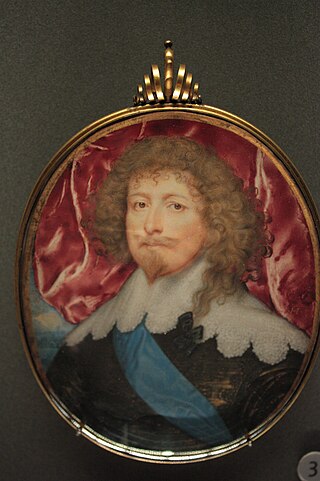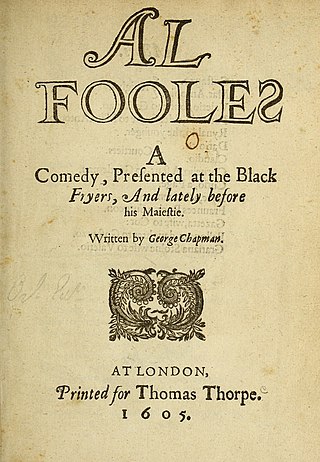Related Research Articles

James Shirley was an English dramatist.

Sir Kenelm Digby was an English courtier and diplomat. He was also a highly reputed natural philosopher, astrologer and known as a leading Roman Catholic intellectual and Blackloist. For his versatility, he is described in John Pointer's Oxoniensis Academia (1749) as the "Magazine of all Arts and Sciences, or the Ornament of this Nation".

Venetia Anastasia, Lady Digby was a celebrated beauty of the Stuart period and the wife of a prominent courtier and scientist, Sir Kenelm Digby. She was a granddaughter of Thomas Percy, 7th Earl of Northumberland and a great-granddaughter of Edward Stanley, 3rd Earl of Derby.

Edward Sackville, 4th Earl of Dorset KG was an English courtier, soldier and politician. He sat in the House of Commons from 1621 to 1622 and became Earl of Dorset in 1624. He fought a duel in his early life, and was later involved in colonisation in North America. He supported the Royalist cause in the English Civil War.
The Night Walker, or The Little Thief is an early seventeenth-century stage play, a comedy written by John Fletcher and later revised by his younger contemporary James Shirley. It was first published in 1640.
The Coronation is a Caroline era stage play, a tragicomedy written by James Shirley, and notable for the tug-of-war of authorship claims in which it was involved in the middle seventeenth century.

A Fair Quarrel is a Jacobean tragicomedy, a collaboration between Thomas Middleton and William Rowley that was first published in 1617.

The Gamester is a Caroline era stage play, a comedy of manners written by James Shirley, premiered in 1633 and first published in 1637. The play is noteworthy for its realistic and detailed picture of gambling in its era.
Love's Sacrifice is a Caroline era stage play, a tragedy written by John Ford, and first published in 1633. It is one of Ford's three surviving solo tragedies, the others being The Broken Heart and 'Tis Pity She's a Whore.
The Changes, or Love in a Maze is a Caroline era stage play, a comedy of manners written by James Shirley, first published in 1639. It was one of Shirley's most popular comedies, especially in the Restoration era. The play is almost universally known by its subtitle.
The Example is a Caroline era stage play, a comedy written by James Shirley, first published in 1637. The play has repeatedly been acclaimed both as one of Shirley's best comedies and one of the best works of its generation. And it provides one of the clearest demonstrations in Shirley's canon of the influence of the works of Ben Jonson on the younger dramatist's output.
The Maid's Revenge is an early Caroline era stage the play, the earliest extant tragedy by James Shirley. It was first published in 1639.
The Politician is a Caroline era stage play, a tragedy written by James Shirley, and first published in 1655.
The Renegado, or The Gentleman of Venice is a late Jacobean stage play, a tragicomedy written by Philip Massinger and first published in 1630. The play has attracted critical attention for its treatment of cultural conflict between Christian Europe and Muslim North Africa.
A Cure for a Cuckold is a late Jacobean era stage play. It is a comedy written by John Webster and William Rowley. The play was first published in 1661, though it is understood to have been composed some four decades earlier.

All Fools is an early Jacobean era stage play, a comedy by George Chapman that was first published in 1605. The play has often been considered Chapman's highest achievement in comedy: "not only Chapman's most flawless, perfectly balanced play," but "also his most human and large-minded." "Chapman certainly wrote no comedy in which an ingenious and well-managed plot combined so harmoniously with personages so distinctly conceived and so cleverly and divertingly executed."
The English Moor, or the Mock Marriage is a Caroline era stage play, a comedy written by Richard Brome, noteworthy in its use of the stage device of blackface make-up. Registered in 1640, it was first printed in 1659, and, uniquely among the plays of Brome's canon, also survives in a manuscript version.
Pathomachia, or the Battle of Affections, also known as Love's Lodestone, is an early 17th-century play, first printed in 1630. It is an allegory that presents a range of problems to scholars of the drama of the Jacobean and Caroline eras.

Henrietta Maria of France was Queen of England, Scotland and Ireland from her marriage to King Charles I on 13 June 1625 until Charles was executed on 30 January 1649. She was mother of his sons Charles II and James II and VII. Contemporaneously, by a decree of her husband, she was known in England as 'Queen Mary', but she did not like this name and signed her letters "Henriette R" or "Henriette Marie R".
George Kirke was a Scottish-born courtier and Member of Parliament for Clitheroe.
References
- ↑ Arthur Huntingdon Nason, James Shirley, Dramatist: A Biographical and Critical Study, New York, Columbia University, 1915; pp. 41, 74-6 and ff.
- ↑ Alfred Harbage, "Shirley's The Wedding and the Marriage of Sir Kenelm Digby," Philological Quarterly 16 (1937), pp. 35-40.